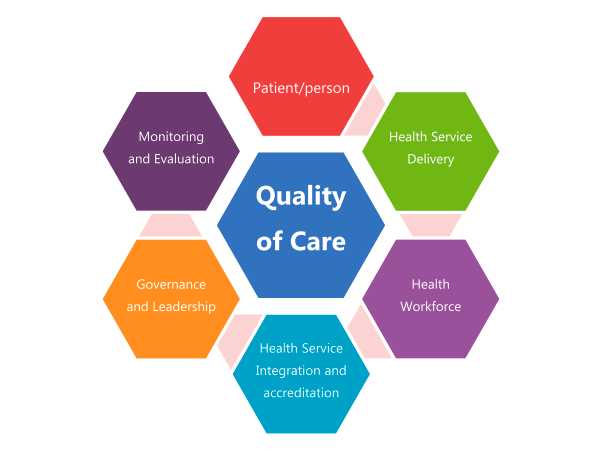The Ministry of Health and Population (MoHP) Nepal has released the National Health Care Quality Assurance Framework to provide guidance for policymakers, program managers, and health planners at the national, district, and facility levels. It is also intended for maternal and newborn health professionals, non-governmental organizations (NGOs), including private-sector health organizations involved or interested in the provision of maternal and newborn health services, as well as community organizations interested in improving the quality of health services. This Framework serves as a toolkit or an umbrella, which brings together and organizes the full range of evidence-based quality policies, standards, guidelines, protocols, tools, and practices in a single framework and provides necessary guidance and direction.
Purpose
- To improve performance, reduce risk and achieve sustainable growth
- To ensure high quality, effective, accountable, and evidence-based services
- To measure the impact of service provision on both client, family, and community
- To meet national and local performance standards
- To contribute to the development of an organization-wide culture of ongoing quality assurance and quality improvement
- To support high-quality governance standards
- To link to strategic plans and initiatives (local, province, and federal government.
Commonly used QI tools/approaches in the Health Sector
- Minimum Service Standards
- Quality Improvement Tools
- POCQI – Point of Care Quality Improvement Hospitals
- Standard Treatment Guidelines and Protocols
- Coaching and Mentoring Tool for MNH Service Providers
- Client Feedback Tools/Mechanisms
- Review Meetings (including focused review e.g., MPDSR)
- MNH Readiness QI tool for Hospital
- MNH Readiness QI tool for Birthing Center
- Robson Implementation guideline
- QI tool for Skilled Birth Attendant (SBA) and Mid-Level Practicum (MLP) Training Sites
Quality of care (six domains)

Key roles for quality assurance and monitoring mechanisms
Federal Level
MoHP (Quality Assurance and Regulation Division)
- Preparing, reviewing, and facilitating implication of national quality assurance policies and guidelines
- Establishing service standards and monitoring for all services and types of facilities
- Guidance and monitoring of the quality of services being delivered by all types of health facilities
- Review and monitoring of service provision and quality of services delivered
- Establishing quality standards for drugs, commodities, equipment, and medical supplies
- Ensuring requirements as per the International Health Regulation (IHR)
- Facilitating registration, renewal, and monitoring of health facilities based on their established criteria and norms.
DoHS
- Facilitating implementation, monitoring, and review of the delivery of health services and quality of those services
- Supporting MoHP in preparation of quality-of-care related policies, protocols, and guidelines of MoHP
- Ensuring delivery of essential services by all basic health care facilities and other services as per the protocol and health policies.
Divisions/ Centers
- Developing program-specific technical guidance and protocols to ensure preparedness and delivery of health services.
Province Level
MoSD/MoHP
- Prepare and implement provincial policies, acts, quality standards, and implementation guidelines
- Ensure delivery of essential services by all facilities and other services as per the policy and protocols
- Facilitate registration, operation, listing, and regulation of private and cooperative health facilities as per the policy and protocols
- Facilitate production, and use of health-related commodities, medicines and ensuring the quality of imported medicines and commodities.
Directorate/ Centers
- Management of logistics and supply chain system of medicines, health commodities, and supplies
- Facilitate implementation, monitoring, and review of the delivery of health services and quality of those services by provincial-level health facilities
- Facilitate dissemination and implementation of program[1]specific technical guidance and protocols.
Health Offices (district level)
- Coordinate with the municipal, district, and provincial level authorities to ensure delivery of health services as per the policy and protocol.
Local Level
Municipality
- Ensure delivery of basic health and sanitation services as per the federal, provincial, and local health policies, standards, and protocols
- Facilitate dissemination of information for public awareness and demand creation
- Coordinate with other sections/sectors to create clean, healthy, and resilient societies
Hospital/Health Facility
- Deliver basic health services as outlined in federal, provincial, and local health policies and by ensuring national standards and protocols.
Do you have a website? Looking for the best hosting provider? Here’s a discount code.
Latest Public Health Jobs
Latest Posts
- Monitoring progress on UHC and the health-related SDGs in the South-East Asia Region: 2025 update
- Resolutions and Decisions of the WHO South-East Asia Regional Committee
- Guidelines on Hand Hygiene in Community Settings
- Global Antibiotic Resistance Surveillance Report 2025
- Maldives becomes the first country to achieve ‘triple elimination’ of mother-to-child transmission of HIV, Syphilis and Hepatitis B
Thanks for visiting us.
Disclaimer: The resources, documents, guidelines, and information on this blog have been collected from various sources and are intended for informational purposes only. Information published on or through this website and affiliated social media channels does not represent the intention, plan, or strategies of an organization that the initiator is associated with in a professional or personal capacity, unless explicitly indicated.
If you have any complaints, information, or suggestions about the content published on Public Health Update, please feel free to contact us at blog.publichealthupdate@gmail.com.
#StayUpdated


